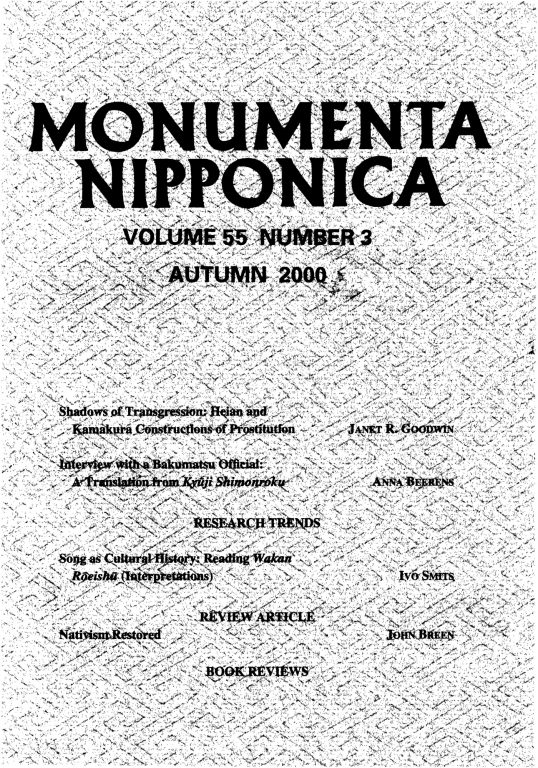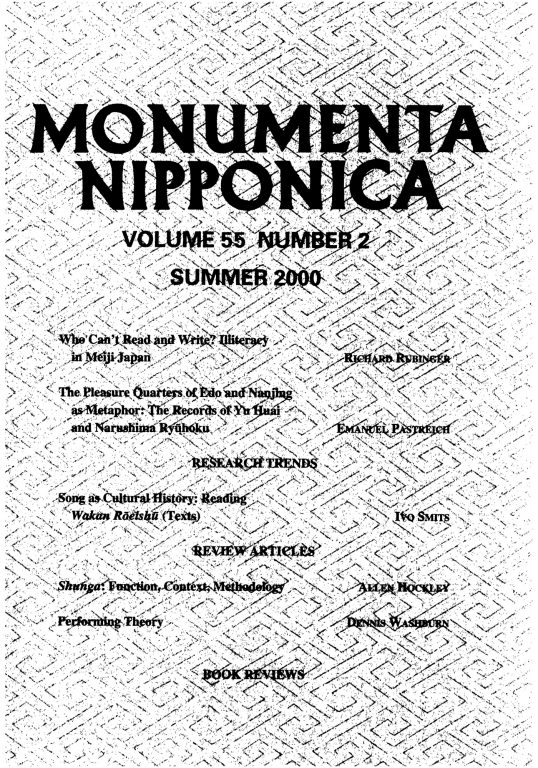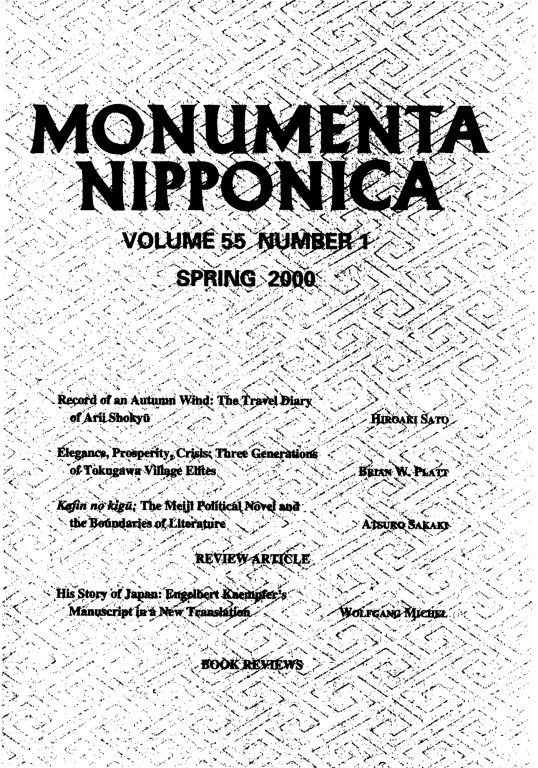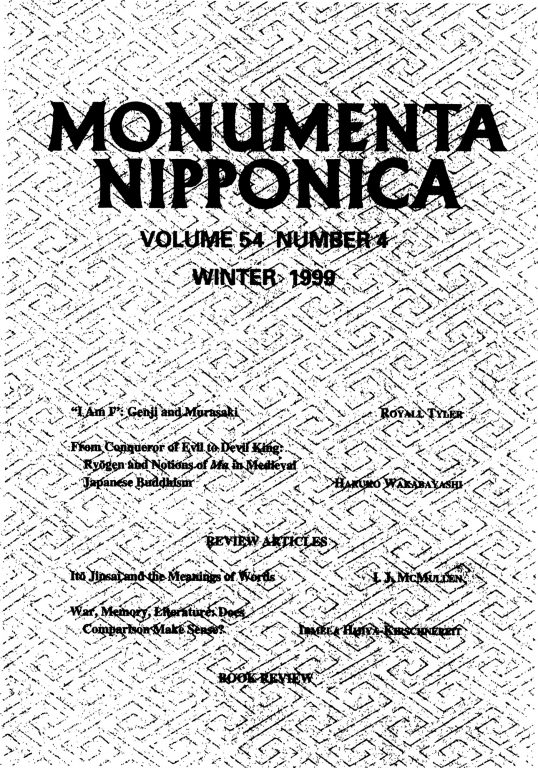Founded in 1938 and published semiannually by Sophia University MN 55:3 (2000) 473–75Learning in Likely Places: Varieties of Apprenticeship in Japan by John SingletonEyal Ben-Ari
MN 55:3 (2000) 473–75Learning in Likely Places: Varieties of Apprenticeship in Japan by John SingletonEyal Ben-Ari MN 55:3 (2000) 475–77Managing Decline: Japan’s Coal Industry Restructuring and Community Response by Suzanne CulterMatthew Allen
MN 55:3 (2000) 475–77Managing Decline: Japan’s Coal Industry Restructuring and Community Response by Suzanne CulterMatthew Allen MN 55:3 (2000) 477–79From Book to Screen: Modern Japanese Literature in Film by Keiko I. McDonaldDavid Desser
MN 55:3 (2000) 477–79From Book to Screen: Modern Japanese Literature in Film by Keiko I. McDonaldDavid Desser MN 55:2 (2000) 163–98Who Can’t Read and Write? Illiteracy in Meiji JapanRichard Rubinger
MN 55:2 (2000) 163–98Who Can’t Read and Write? Illiteracy in Meiji JapanRichard Rubinger MN 55:2 (2000) 199–224The Pleasure Quarters of Edo and Nanjing as Metaphor: The Records of Yu Huai and Narushima RyūhokuEmanuel Pastreich
MN 55:2 (2000) 199–224The Pleasure Quarters of Edo and Nanjing as Metaphor: The Records of Yu Huai and Narushima RyūhokuEmanuel Pastreich MN 55:2 (2000) 225–56Song as Cultural History: Reading Wakan Rōeishū (Part 1: Texts)Ivo Smits
MN 55:2 (2000) 225–56Song as Cultural History: Reading Wakan Rōeishū (Part 1: Texts)Ivo Smits MN 55:2 (2000) 257–69Shunga: Function, Context, MethodologyAllen Hockley
MN 55:2 (2000) 257–69Shunga: Function, Context, MethodologyAllen Hockley MN 55:2 (2000) 271–81Performing TheoryDennis Washburn
MN 55:2 (2000) 271–81Performing TheoryDennis Washburn MN 55:2 (2000) 283–85Ruins of Identity: Ethnogenesis in the Japanese Islands by Mark J. HudsonBruce L. Batten
MN 55:2 (2000) 283–85Ruins of Identity: Ethnogenesis in the Japanese Islands by Mark J. HudsonBruce L. Batten MN 55:2 (2000) 285–88Heian Japan. Volume 2 of The Cambridge History of Japan by Donald H. Shively, William H. McCulloughWilliam Wayne Farris
MN 55:2 (2000) 285–88Heian Japan. Volume 2 of The Cambridge History of Japan by Donald H. Shively, William H. McCulloughWilliam Wayne Farris MN 55:2 (2000) 288–91Even the Gods Rebel: The Peasants of Takaino and the 1871 Nakano Uprising in Japan by Selçuk EsenbelPatricia Sippel
MN 55:2 (2000) 288–91Even the Gods Rebel: The Peasants of Takaino and the 1871 Nakano Uprising in Japan by Selçuk EsenbelPatricia Sippel MN 55:2 (2000) 291–93War and National Reinvention: Japan in the Great War, 1914–1919 by Frederick R. DickinsonJames L. Huffman
MN 55:2 (2000) 291–93War and National Reinvention: Japan in the Great War, 1914–1919 by Frederick R. DickinsonJames L. Huffman MN 55:2 (2000) 293–96Passages to Modernity: Motherhood, Childhood, and Social Reform in Early Twentieth-Century Japan by Kathleen S. UnoDavid R. Ambaras
MN 55:2 (2000) 293–96Passages to Modernity: Motherhood, Childhood, and Social Reform in Early Twentieth-Century Japan by Kathleen S. UnoDavid R. Ambaras MN 55:2 (2000) 296–98Modern Girls, Shining Stars, The Skies of Tokyo: Five Japanese Women by Phyllis BirnbaumRichmod Bollinger
MN 55:2 (2000) 296–98Modern Girls, Shining Stars, The Skies of Tokyo: Five Japanese Women by Phyllis BirnbaumRichmod Bollinger MN 55:2 (2000) 298–300Soundings in Time: The Fictive Art of Yasunari Kawabata by Roy StarrsGiorgio Amitrano
MN 55:2 (2000) 298–300Soundings in Time: The Fictive Art of Yasunari Kawabata by Roy StarrsGiorgio Amitrano MN 55:2 (2000) 300–302The Legend of Gold and Other Stories by Ishikawa Jun, William J. TylerAngela Yiu
MN 55:2 (2000) 300–302The Legend of Gold and Other Stories by Ishikawa Jun, William J. TylerAngela Yiu MN 55:2 (2000) 302–305Mirror: The Fiction and Essays of Kōda Aya by Ann SherifMaryellen Toman Mori
MN 55:2 (2000) 302–305Mirror: The Fiction and Essays of Kōda Aya by Ann SherifMaryellen Toman Mori MN 55:2 (2000) 305–307Ōe and Beyond: Fiction in Contemporary Japan by Stephen Snyder, Philip GabrielSeiji M. Lippit
MN 55:2 (2000) 305–307Ōe and Beyond: Fiction in Contemporary Japan by Stephen Snyder, Philip GabrielSeiji M. Lippit MN 55:2 (2000) 307–10Buddhistische Zeremoniale [Kōshiki] und ihre Bedeutung für die Literatur des japanischen Mittelalters by Niels GülbergHartmut O. Rotermund
MN 55:2 (2000) 307–10Buddhistische Zeremoniale [Kōshiki] und ihre Bedeutung für die Literatur des japanischen Mittelalters by Niels GülbergHartmut O. Rotermund MN 55:2 (2000) 310–12The Fox and the Jewel: Shared and Private Meanings in Contemporary Japanese Inari Worship by Karen A. SmyersKlaus Antoni
MN 55:2 (2000) 310–12The Fox and the Jewel: Shared and Private Meanings in Contemporary Japanese Inari Worship by Karen A. SmyersKlaus Antoni MN 55:2 (2000) 312–15The Spirit of Tsugaru: Blind Musicians, Tsugaru-jamisen, and the Folk Music of Northern Japan. With the Autobiography of Takahashi Chikuzan by Gerald GroemerIngrid Fritsch
MN 55:2 (2000) 312–15The Spirit of Tsugaru: Blind Musicians, Tsugaru-jamisen, and the Folk Music of Northern Japan. With the Autobiography of Takahashi Chikuzan by Gerald GroemerIngrid Fritsch MN 55:2 (2000) 315–17Riding the Black Ship: Japan and Tokyo Disneyland by Aviad E. RazAnne Allison
MN 55:2 (2000) 315–17Riding the Black Ship: Japan and Tokyo Disneyland by Aviad E. RazAnne Allison MN 55:2 (2000) 317–19Wörterbücher und Glossare. Eine teilannotierte Bibliographie japanisch-deutscher und deutsch-japanischer Nachschlagewerke. Wa-Doku Doku-Wa jisho, yōgoshū kaidai by Jürgen Stalph, Harald SuppanschitschHartmut Walravens
MN 55:2 (2000) 317–19Wörterbücher und Glossare. Eine teilannotierte Bibliographie japanisch-deutscher und deutsch-japanischer Nachschlagewerke. Wa-Doku Doku-Wa jisho, yōgoshū kaidai by Jürgen Stalph, Harald SuppanschitschHartmut Walravens MN 55:2 (2000) 321–23CorrespondenceJohn Allen Tucker
MN 55:2 (2000) 321–23CorrespondenceJohn Allen Tucker MN 55:1 (2000) 1–43Record of an Autumn Wind: The Travel Diary of Arii ShokyūHiroaki Sato
MN 55:1 (2000) 1–43Record of an Autumn Wind: The Travel Diary of Arii ShokyūHiroaki Sato MN 55:1 (2000) 14–43Record of an Autumn WindArii Shokyū, Translated by Hiroaki Sato
MN 55:1 (2000) 14–43Record of an Autumn WindArii Shokyū, Translated by Hiroaki Sato MN 55:1 (2000) 45–81Elegance, Prosperity, Crisis: Three Generations of Tokugawa Village ElitesBrian W. Platt
MN 55:1 (2000) 45–81Elegance, Prosperity, Crisis: Three Generations of Tokugawa Village ElitesBrian W. Platt MN 55:1 (2000) 83–108Kajin no Kigū: The Meiji Political Novel and the Boundaries of LiteratureAtsuko Sakaki
MN 55:1 (2000) 83–108Kajin no Kigū: The Meiji Political Novel and the Boundaries of LiteratureAtsuko Sakaki MN 55:1 (2000) 109–20His Story of Japan: Engelbert Kaempfer’s Manuscript in a New TranslationWolfgang Michel
MN 55:1 (2000) 109–20His Story of Japan: Engelbert Kaempfer’s Manuscript in a New TranslationWolfgang Michel MN 55:1 (2000) 121–23Osaka: The Merchants’ Capital of Early Modern Japan by James L. McClain, Wakita OsamuAnne Walthall
MN 55:1 (2000) 121–23Osaka: The Merchants’ Capital of Early Modern Japan by James L. McClain, Wakita OsamuAnne Walthall MN 55:1 (2000) 124–27The Japanese Discovery of Victorian Britain: Early Travel Encounters in the Far West by Andrew Cobbing; The Iwakura Mission in America and Europe: A New Assessment by Ian NishM. William Steele
MN 55:1 (2000) 124–27The Japanese Discovery of Victorian Britain: Early Travel Encounters in the Far West by Andrew Cobbing; The Iwakura Mission in America and Europe: A New Assessment by Ian NishM. William Steele MN 55:1 (2000) 128–29Embracing Defeat: Japan in the Wake of World War II by John W. DowerSimon Partner
MN 55:1 (2000) 128–29Embracing Defeat: Japan in the Wake of World War II by John W. DowerSimon Partner MN 55:1 (2000) 129–32Entstehung und Morphologie des klassischen Kyōgen im 17. Jahrhundert: Vom mittelalterlichen Theater der Aussenseiter zum Kammerspiel des Shogunats by Stanca Scholz-CioncaGünter Zobel
MN 55:1 (2000) 129–32Entstehung und Morphologie des klassischen Kyōgen im 17. Jahrhundert: Vom mittelalterlichen Theater der Aussenseiter zum Kammerspiel des Shogunats by Stanca Scholz-CioncaGünter Zobel MN 55:1 (2000) 132–35Wandering Heart: The Work and Method of Hayashi Fumiko by Susanna FesslerEve Zimmerman
MN 55:1 (2000) 132–35Wandering Heart: The Work and Method of Hayashi Fumiko by Susanna FesslerEve Zimmerman MN 55:1 (2000) 135–38Gender Is Fair Game: (Re)Thinking the (Fe)Male in the Works of Ōba Minako by Michiko Niikuni WilsonEileen B. Mikals-Adachi
MN 55:1 (2000) 135–38Gender Is Fair Game: (Re)Thinking the (Fe)Male in the Works of Ōba Minako by Michiko Niikuni WilsonEileen B. Mikals-Adachi MN 55:1 (2000) 138–39Wasser-Spuren: Festschrift für Wolfram Naumann zum 65. Geburtstag by Stanca Scholz-CioncaJohann Nawrocki
MN 55:1 (2000) 138–39Wasser-Spuren: Festschrift für Wolfram Naumann zum 65. Geburtstag by Stanca Scholz-CioncaJohann Nawrocki MN 55:1 (2000) 139–42Hōnen’s Senchakushū: Passages on the Selection of the Nembutsu in the Original Vow (Senchaku hongan nembutsu shū) by Senchakushū English Translation ProjectDennis Hirota
MN 55:1 (2000) 139–42Hōnen’s Senchakushū: Passages on the Selection of the Nembutsu in the Original Vow (Senchaku hongan nembutsu shū) by Senchakushū English Translation ProjectDennis Hirota MN 55:1 (2000) 142–44Japans Blinde Sänger im Schutz der Gottheit Myōon-Benzaiten by Ingrid FritschSilvain Guignard
MN 55:1 (2000) 142–44Japans Blinde Sänger im Schutz der Gottheit Myōon-Benzaiten by Ingrid FritschSilvain Guignard MN 55:1 (2000) 144–46Practically Religious: Worldly Benefits and the Common Religion of Japan by Ian Reader, George J. Tanabe, Jr.Karen A. Smyers
MN 55:1 (2000) 144–46Practically Religious: Worldly Benefits and the Common Religion of Japan by Ian Reader, George J. Tanabe, Jr.Karen A. Smyers MN 55:1 (2000) 147–49Interkulturelle Philosophie und Phänomenologie in Japan by Tadashi Ogawa, Michael Lazarin, Guido RappeJoseph S. O'Leary
MN 55:1 (2000) 147–49Interkulturelle Philosophie und Phänomenologie in Japan by Tadashi Ogawa, Michael Lazarin, Guido RappeJoseph S. O'Leary MN 55:1 (2000) 149–52Hiroshima Traces: Time, Space, and the Dialectics of Memory by Lisa YoneyamaGerald Figal
MN 55:1 (2000) 149–52Hiroshima Traces: Time, Space, and the Dialectics of Memory by Lisa YoneyamaGerald Figal MN 55:1 (2000) 152–54Zen Buddhist Landscape Arts in Early Muromachi Japan (1336–1573) by Joseph D. ParkerSonja Arntzen
MN 55:1 (2000) 152–54Zen Buddhist Landscape Arts in Early Muromachi Japan (1336–1573) by Joseph D. ParkerSonja Arntzen MN 55:1 (2000) 154–57Hiraizumi: Buddhist Art and Regional Politics in Twelfth-Century Japan by Mimi Hall YiengpruksawanSamuel C. Morse
MN 55:1 (2000) 154–57Hiraizumi: Buddhist Art and Regional Politics in Twelfth-Century Japan by Mimi Hall YiengpruksawanSamuel C. Morse MN 55:1 (2000) 157–59Pachinko monogatari: Soziokulturelle Exploration der japanischen Glücks- spielindustrie by Wolfram ManzenreiterStanca Scholz-Cionca
MN 55:1 (2000) 157–59Pachinko monogatari: Soziokulturelle Exploration der japanischen Glücks- spielindustrie by Wolfram ManzenreiterStanca Scholz-Cionca MN 54:4 (1999) 435–80“I Am I”: Genji and MurasakiRoyall Tyler
MN 54:4 (1999) 435–80“I Am I”: Genji and MurasakiRoyall Tyler MN 54:4 (1999) 481–507From Conqueror of Evil to Devil King: Ryōgen and Notions of Ma in Medieval Japanese BuddhismHaruko Wakabayashi
MN 54:4 (1999) 481–507From Conqueror of Evil to Devil King: Ryōgen and Notions of Ma in Medieval Japanese BuddhismHaruko Wakabayashi MN 54:4 (1999) 509–520Itō Jinsai and the Meanings of WordsI. J. McMullen
MN 54:4 (1999) 509–520Itō Jinsai and the Meanings of WordsI. J. McMullen MN 54:4 (1999) 521–528War, Memory, Literature: Does Comparison Make Sense?Irmela Hijiya-Kirschnereit
MN 54:4 (1999) 521–528War, Memory, Literature: Does Comparison Make Sense?Irmela Hijiya-Kirschnereit
 MN 55:3 (2000) 473–75Learning in Likely Places: Varieties of Apprenticeship in Japan by John SingletonEyal Ben-Ari
MN 55:3 (2000) 473–75Learning in Likely Places: Varieties of Apprenticeship in Japan by John SingletonEyal Ben-Ari MN 55:3 (2000) 475–77Managing Decline: Japan’s Coal Industry Restructuring and Community Response by Suzanne CulterMatthew Allen
MN 55:3 (2000) 475–77Managing Decline: Japan’s Coal Industry Restructuring and Community Response by Suzanne CulterMatthew Allen MN 55:3 (2000) 477–79From Book to Screen: Modern Japanese Literature in Film by Keiko I. McDonaldDavid Desser
MN 55:3 (2000) 477–79From Book to Screen: Modern Japanese Literature in Film by Keiko I. McDonaldDavid Desser MN 55:2 (2000) 163–98Who Can’t Read and Write? Illiteracy in Meiji JapanRichard Rubinger
MN 55:2 (2000) 163–98Who Can’t Read and Write? Illiteracy in Meiji JapanRichard Rubinger MN 55:2 (2000) 199–224The Pleasure Quarters of Edo and Nanjing as Metaphor: The Records of Yu Huai and Narushima RyūhokuEmanuel Pastreich
MN 55:2 (2000) 199–224The Pleasure Quarters of Edo and Nanjing as Metaphor: The Records of Yu Huai and Narushima RyūhokuEmanuel Pastreich MN 55:2 (2000) 225–56Song as Cultural History: Reading Wakan Rōeishū (Part 1: Texts)Ivo Smits
MN 55:2 (2000) 225–56Song as Cultural History: Reading Wakan Rōeishū (Part 1: Texts)Ivo Smits MN 55:2 (2000) 257–69Shunga: Function, Context, MethodologyAllen Hockley
MN 55:2 (2000) 257–69Shunga: Function, Context, MethodologyAllen Hockley MN 55:2 (2000) 271–81Performing TheoryDennis Washburn
MN 55:2 (2000) 271–81Performing TheoryDennis Washburn MN 55:2 (2000) 283–85Ruins of Identity: Ethnogenesis in the Japanese Islands by Mark J. HudsonBruce L. Batten
MN 55:2 (2000) 283–85Ruins of Identity: Ethnogenesis in the Japanese Islands by Mark J. HudsonBruce L. Batten MN 55:2 (2000) 285–88Heian Japan. Volume 2 of The Cambridge History of Japan by Donald H. Shively, William H. McCulloughWilliam Wayne Farris
MN 55:2 (2000) 285–88Heian Japan. Volume 2 of The Cambridge History of Japan by Donald H. Shively, William H. McCulloughWilliam Wayne Farris MN 55:2 (2000) 288–91Even the Gods Rebel: The Peasants of Takaino and the 1871 Nakano Uprising in Japan by Selçuk EsenbelPatricia Sippel
MN 55:2 (2000) 288–91Even the Gods Rebel: The Peasants of Takaino and the 1871 Nakano Uprising in Japan by Selçuk EsenbelPatricia Sippel MN 55:2 (2000) 291–93War and National Reinvention: Japan in the Great War, 1914–1919 by Frederick R. DickinsonJames L. Huffman
MN 55:2 (2000) 291–93War and National Reinvention: Japan in the Great War, 1914–1919 by Frederick R. DickinsonJames L. Huffman MN 55:2 (2000) 293–96Passages to Modernity: Motherhood, Childhood, and Social Reform in Early Twentieth-Century Japan by Kathleen S. UnoDavid R. Ambaras
MN 55:2 (2000) 293–96Passages to Modernity: Motherhood, Childhood, and Social Reform in Early Twentieth-Century Japan by Kathleen S. UnoDavid R. Ambaras MN 55:2 (2000) 296–98Modern Girls, Shining Stars, The Skies of Tokyo: Five Japanese Women by Phyllis BirnbaumRichmod Bollinger
MN 55:2 (2000) 296–98Modern Girls, Shining Stars, The Skies of Tokyo: Five Japanese Women by Phyllis BirnbaumRichmod Bollinger MN 55:2 (2000) 298–300Soundings in Time: The Fictive Art of Yasunari Kawabata by Roy StarrsGiorgio Amitrano
MN 55:2 (2000) 298–300Soundings in Time: The Fictive Art of Yasunari Kawabata by Roy StarrsGiorgio Amitrano MN 55:2 (2000) 300–302The Legend of Gold and Other Stories by Ishikawa Jun, William J. TylerAngela Yiu
MN 55:2 (2000) 300–302The Legend of Gold and Other Stories by Ishikawa Jun, William J. TylerAngela Yiu MN 55:2 (2000) 302–305Mirror: The Fiction and Essays of Kōda Aya by Ann SherifMaryellen Toman Mori
MN 55:2 (2000) 302–305Mirror: The Fiction and Essays of Kōda Aya by Ann SherifMaryellen Toman Mori MN 55:2 (2000) 305–307Ōe and Beyond: Fiction in Contemporary Japan by Stephen Snyder, Philip GabrielSeiji M. Lippit
MN 55:2 (2000) 305–307Ōe and Beyond: Fiction in Contemporary Japan by Stephen Snyder, Philip GabrielSeiji M. Lippit MN 55:2 (2000) 307–10Buddhistische Zeremoniale [Kōshiki] und ihre Bedeutung für die Literatur des japanischen Mittelalters by Niels GülbergHartmut O. Rotermund
MN 55:2 (2000) 307–10Buddhistische Zeremoniale [Kōshiki] und ihre Bedeutung für die Literatur des japanischen Mittelalters by Niels GülbergHartmut O. Rotermund MN 55:2 (2000) 310–12The Fox and the Jewel: Shared and Private Meanings in Contemporary Japanese Inari Worship by Karen A. SmyersKlaus Antoni
MN 55:2 (2000) 310–12The Fox and the Jewel: Shared and Private Meanings in Contemporary Japanese Inari Worship by Karen A. SmyersKlaus Antoni MN 55:2 (2000) 312–15The Spirit of Tsugaru: Blind Musicians, Tsugaru-jamisen, and the Folk Music of Northern Japan. With the Autobiography of Takahashi Chikuzan by Gerald GroemerIngrid Fritsch
MN 55:2 (2000) 312–15The Spirit of Tsugaru: Blind Musicians, Tsugaru-jamisen, and the Folk Music of Northern Japan. With the Autobiography of Takahashi Chikuzan by Gerald GroemerIngrid Fritsch MN 55:2 (2000) 315–17Riding the Black Ship: Japan and Tokyo Disneyland by Aviad E. RazAnne Allison
MN 55:2 (2000) 315–17Riding the Black Ship: Japan and Tokyo Disneyland by Aviad E. RazAnne Allison MN 55:2 (2000) 317–19Wörterbücher und Glossare. Eine teilannotierte Bibliographie japanisch-deutscher und deutsch-japanischer Nachschlagewerke. Wa-Doku Doku-Wa jisho, yōgoshū kaidai by Jürgen Stalph, Harald SuppanschitschHartmut Walravens
MN 55:2 (2000) 317–19Wörterbücher und Glossare. Eine teilannotierte Bibliographie japanisch-deutscher und deutsch-japanischer Nachschlagewerke. Wa-Doku Doku-Wa jisho, yōgoshū kaidai by Jürgen Stalph, Harald SuppanschitschHartmut Walravens MN 55:2 (2000) 321–23CorrespondenceJohn Allen Tucker
MN 55:2 (2000) 321–23CorrespondenceJohn Allen Tucker MN 55:1 (2000) 1–43Record of an Autumn Wind: The Travel Diary of Arii ShokyūHiroaki Sato
MN 55:1 (2000) 1–43Record of an Autumn Wind: The Travel Diary of Arii ShokyūHiroaki Sato MN 55:1 (2000) 14–43Record of an Autumn WindArii Shokyū, Translated by Hiroaki Sato
MN 55:1 (2000) 14–43Record of an Autumn WindArii Shokyū, Translated by Hiroaki Sato MN 55:1 (2000) 45–81Elegance, Prosperity, Crisis: Three Generations of Tokugawa Village ElitesBrian W. Platt
MN 55:1 (2000) 45–81Elegance, Prosperity, Crisis: Three Generations of Tokugawa Village ElitesBrian W. Platt MN 55:1 (2000) 83–108Kajin no Kigū: The Meiji Political Novel and the Boundaries of LiteratureAtsuko Sakaki
MN 55:1 (2000) 83–108Kajin no Kigū: The Meiji Political Novel and the Boundaries of LiteratureAtsuko Sakaki MN 55:1 (2000) 109–20His Story of Japan: Engelbert Kaempfer’s Manuscript in a New TranslationWolfgang Michel
MN 55:1 (2000) 109–20His Story of Japan: Engelbert Kaempfer’s Manuscript in a New TranslationWolfgang Michel MN 55:1 (2000) 121–23Osaka: The Merchants’ Capital of Early Modern Japan by James L. McClain, Wakita OsamuAnne Walthall
MN 55:1 (2000) 121–23Osaka: The Merchants’ Capital of Early Modern Japan by James L. McClain, Wakita OsamuAnne Walthall MN 55:1 (2000) 124–27The Japanese Discovery of Victorian Britain: Early Travel Encounters in the Far West by Andrew Cobbing; The Iwakura Mission in America and Europe: A New Assessment by Ian NishM. William Steele
MN 55:1 (2000) 124–27The Japanese Discovery of Victorian Britain: Early Travel Encounters in the Far West by Andrew Cobbing; The Iwakura Mission in America and Europe: A New Assessment by Ian NishM. William Steele MN 55:1 (2000) 128–29Embracing Defeat: Japan in the Wake of World War II by John W. DowerSimon Partner
MN 55:1 (2000) 128–29Embracing Defeat: Japan in the Wake of World War II by John W. DowerSimon Partner MN 55:1 (2000) 129–32Entstehung und Morphologie des klassischen Kyōgen im 17. Jahrhundert: Vom mittelalterlichen Theater der Aussenseiter zum Kammerspiel des Shogunats by Stanca Scholz-CioncaGünter Zobel
MN 55:1 (2000) 129–32Entstehung und Morphologie des klassischen Kyōgen im 17. Jahrhundert: Vom mittelalterlichen Theater der Aussenseiter zum Kammerspiel des Shogunats by Stanca Scholz-CioncaGünter Zobel MN 55:1 (2000) 132–35Wandering Heart: The Work and Method of Hayashi Fumiko by Susanna FesslerEve Zimmerman
MN 55:1 (2000) 132–35Wandering Heart: The Work and Method of Hayashi Fumiko by Susanna FesslerEve Zimmerman MN 55:1 (2000) 135–38Gender Is Fair Game: (Re)Thinking the (Fe)Male in the Works of Ōba Minako by Michiko Niikuni WilsonEileen B. Mikals-Adachi
MN 55:1 (2000) 135–38Gender Is Fair Game: (Re)Thinking the (Fe)Male in the Works of Ōba Minako by Michiko Niikuni WilsonEileen B. Mikals-Adachi MN 55:1 (2000) 138–39Wasser-Spuren: Festschrift für Wolfram Naumann zum 65. Geburtstag by Stanca Scholz-CioncaJohann Nawrocki
MN 55:1 (2000) 138–39Wasser-Spuren: Festschrift für Wolfram Naumann zum 65. Geburtstag by Stanca Scholz-CioncaJohann Nawrocki MN 55:1 (2000) 139–42Hōnen’s Senchakushū: Passages on the Selection of the Nembutsu in the Original Vow (Senchaku hongan nembutsu shū) by Senchakushū English Translation ProjectDennis Hirota
MN 55:1 (2000) 139–42Hōnen’s Senchakushū: Passages on the Selection of the Nembutsu in the Original Vow (Senchaku hongan nembutsu shū) by Senchakushū English Translation ProjectDennis Hirota MN 55:1 (2000) 142–44Japans Blinde Sänger im Schutz der Gottheit Myōon-Benzaiten by Ingrid FritschSilvain Guignard
MN 55:1 (2000) 142–44Japans Blinde Sänger im Schutz der Gottheit Myōon-Benzaiten by Ingrid FritschSilvain Guignard MN 55:1 (2000) 144–46Practically Religious: Worldly Benefits and the Common Religion of Japan by Ian Reader, George J. Tanabe, Jr.Karen A. Smyers
MN 55:1 (2000) 144–46Practically Religious: Worldly Benefits and the Common Religion of Japan by Ian Reader, George J. Tanabe, Jr.Karen A. Smyers MN 55:1 (2000) 147–49Interkulturelle Philosophie und Phänomenologie in Japan by Tadashi Ogawa, Michael Lazarin, Guido RappeJoseph S. O'Leary
MN 55:1 (2000) 147–49Interkulturelle Philosophie und Phänomenologie in Japan by Tadashi Ogawa, Michael Lazarin, Guido RappeJoseph S. O'Leary MN 55:1 (2000) 149–52Hiroshima Traces: Time, Space, and the Dialectics of Memory by Lisa YoneyamaGerald Figal
MN 55:1 (2000) 149–52Hiroshima Traces: Time, Space, and the Dialectics of Memory by Lisa YoneyamaGerald Figal MN 55:1 (2000) 152–54Zen Buddhist Landscape Arts in Early Muromachi Japan (1336–1573) by Joseph D. ParkerSonja Arntzen
MN 55:1 (2000) 152–54Zen Buddhist Landscape Arts in Early Muromachi Japan (1336–1573) by Joseph D. ParkerSonja Arntzen MN 55:1 (2000) 154–57Hiraizumi: Buddhist Art and Regional Politics in Twelfth-Century Japan by Mimi Hall YiengpruksawanSamuel C. Morse
MN 55:1 (2000) 154–57Hiraizumi: Buddhist Art and Regional Politics in Twelfth-Century Japan by Mimi Hall YiengpruksawanSamuel C. Morse MN 55:1 (2000) 157–59Pachinko monogatari: Soziokulturelle Exploration der japanischen Glücks- spielindustrie by Wolfram ManzenreiterStanca Scholz-Cionca
MN 55:1 (2000) 157–59Pachinko monogatari: Soziokulturelle Exploration der japanischen Glücks- spielindustrie by Wolfram ManzenreiterStanca Scholz-Cionca MN 54:4 (1999) 435–80“I Am I”: Genji and MurasakiRoyall Tyler
MN 54:4 (1999) 435–80“I Am I”: Genji and MurasakiRoyall Tyler MN 54:4 (1999) 481–507From Conqueror of Evil to Devil King: Ryōgen and Notions of Ma in Medieval Japanese BuddhismHaruko Wakabayashi
MN 54:4 (1999) 481–507From Conqueror of Evil to Devil King: Ryōgen and Notions of Ma in Medieval Japanese BuddhismHaruko Wakabayashi MN 54:4 (1999) 509–520Itō Jinsai and the Meanings of WordsI. J. McMullen
MN 54:4 (1999) 509–520Itō Jinsai and the Meanings of WordsI. J. McMullen MN 54:4 (1999) 521–528War, Memory, Literature: Does Comparison Make Sense?Irmela Hijiya-Kirschnereit
MN 54:4 (1999) 521–528War, Memory, Literature: Does Comparison Make Sense?Irmela Hijiya-Kirschnereit